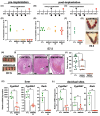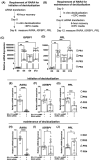Signaling via retinoic acid receptors mediates decidual angiogenesis in mice and human stromal cell decidualization
- PMID: 39777800
- PMCID: PMC11706222
- DOI: 10.1096/fj.202400766R
Signaling via retinoic acid receptors mediates decidual angiogenesis in mice and human stromal cell decidualization
Abstract
At the maternal-fetal interface, tightly regulated levels of retinoic acid (RA), the physiologically active metabolite of vitamin A, are required for embryo implantation and pregnancy success. Herein, we utilize mouse models, primary human cells, and pharmacological tools to demonstrate how depletion of RA signaling via RA receptor (RAR) disrupts implantation and progression of early pregnancy. To inhibit RAR signaling during early pregnancy, BMS493, an inverse pan-RAR agonist that prevents RA-induced differentiation, was administered to pregnant mice during the peri-implantation period. Attenuation of RA/RAR signaling prior to embryo implantation results in implantation failure, whereas attenuation of RA/RAR signaling after embryo implantation disrupts the post-implantation decidual vasculature and results in pregnancy failure by mid-gestation. To inhibit RAR signaling during human endometrial stromal cell (HESC) decidualization, primary HESCs and decidualized primary HESCs were transfected with silencing RNA specific for human RARA. Inhibition of RA/RARA signaling prevents initiation of HESC decidualization, but not maintenance of the decidualized HESC phenotype. These data show that RA/RAR signaling is required for maintenance of the decidual vasculature that supports early pregnancy in mice, and distinct RAR signaling is required for initiation, but not maintenance of primary HESC decidualization in vitro.
© 2025 The Author(s). The FASEB Journal published by Wiley Periodicals LLC on behalf of Federation of American Societies for Experimental Biology.
Conflict of interest statement
The authors have declared that no conflict of interest exists.
Figures







References
-
- Wang H, Dey SK. Roadmap to embryo implantation: clues from mouse models. Nat Rev Genet. 2006;7(3):185‐199. - PubMed
MeSH terms
Substances
Grants and funding
- R01HD109152/HHS | NIH | Eunice Kennedy Shriver National Institute of Child Health and Human Development (NICHD)
- R01AI148695/HHS | National Institutes of Health (NIH)
- T32HD087166/HHS | NIH | Eunice Kennedy Shriver National Institute of Child Health and Human Development (NICHD)
- R01 AI148695/AI/NIAID NIH HHS/United States
- R01 HD109152/HD/NICHD NIH HHS/United States
LinkOut - more resources
Full Text Sources

